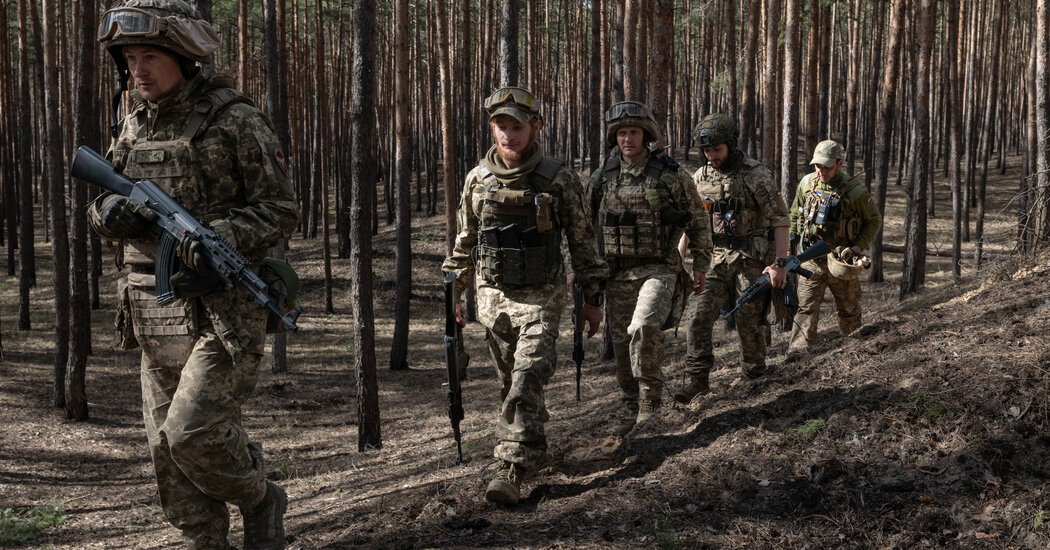President Volodymyr Zelensky of Ukraine has signed into law three measures aimed at replenishing the ranks of his country’s exhausted and battered army, including lowering the age when men become eligible for conscription and eliminating some medical exemptions.
While Mr. Zelensky did not say why he had decided to move ahead on at least some changes, Russia’s forces have been on the offensive along the front line and the ongoing fighting has shrunk Ukraine’s supplies of soldiers and weapons.
Ukraine’s Parliament has for months debated a bill that covers a more sweeping overhaul of conscription, but political analysts say that calling up more men has become an issue that no politician or military leader wants to be associated with. That included Mr. Zelensky, who had delayed for nearly a year signing the bill lowering the draft age.
Ukraine’s army of about one million soldiers is fighting the largest war in Europe since World War II, waged in muddy trenches or the ruins of cities in urban combat. Casualty rates are high. Most men who wanted to volunteer for the military have already done so, and small anti-draft protests had broken out before the new laws were passed.
The new measures, which Parliament had passed last May and which Mr. Zelensky signed into law late Tuesday, lower the draft eligibility age to 25, from 27; eliminate a category of medical exemption known as “partially eligible”; and create an electronic database of men in Ukraine starting at age 17.
Military recruitment offices are authorized to begin drafting younger men on Wednesday.
Ukraine is expected, at best, to hold the existing front lines in ground fighting this year if a new influx of American weapons arrives, military analysts say, and risks falling back without it. To maximize its efforts, Ukraine plans to replenish its army through mobilization while trying to keep Russia off balance with sabotage missions behind enemy lines and long-range drone strikes, such as attacks on an oil refinery and weapons plant in Russia on Tuesday.
Ukraine relies on its allies for most new ammunition and weapons, and renewing that arsenal is mostly a matter beyond the country’s control. In Washington on Monday, the House speaker, Mike Johnson, laid out conditions for a vote on a fresh infusion of American weapons and financial aid, in the strongest indication yet that the assistance could be forthcoming despite opposition from many Republicans.
At home, Ukraine has stumbled on the overhaul of mobilization rules. In January, its Parliament withdrew a draft law on mobilization that included stiffened penalties for draft dodgers. The bill was introduced again, but lawmakers submitted more than 4,000 amendments. A vote was expected this month.
Even with the new change, Ukraine’s draft age is unusually high. The country had drafted men aged 27 to 60, and the average age in the military is over 40. Under martial law, all men 18 to 60 had already been prohibited from leaving the country in case any decision was made to draft them. Men and women can volunteer for military service starting at age 18.
Mr. Zelensky has said he does not intend to conscript women into the military, although women with medical educations are required to register for the draft.
In formulating its mobilization plans, Ukraine has had to balance military, economic and demographic considerations. Lowering the draft age will bring more and healthier soldiers to the fight, but poses long-term risks for sustaining Ukraine’s population, given the country’s demographics.
As in most former Soviet states, Ukraine has a small generation of 20-year-olds, because birthrates plummeted during the deep economic depression of the 1990s. Because of this demographic trough, there are now three times as many men in their 40s as in their 20s in Ukraine.
Drafting men starting at age 25, given the likely battle casualties, also risks further diminishing this small generation of Ukrainians and potentially future birthrates, leaving the country with declines of working- and draft-age men decades from now.
Maria Varenikova contributed reporting.


